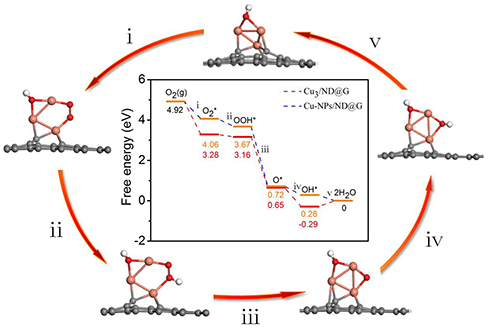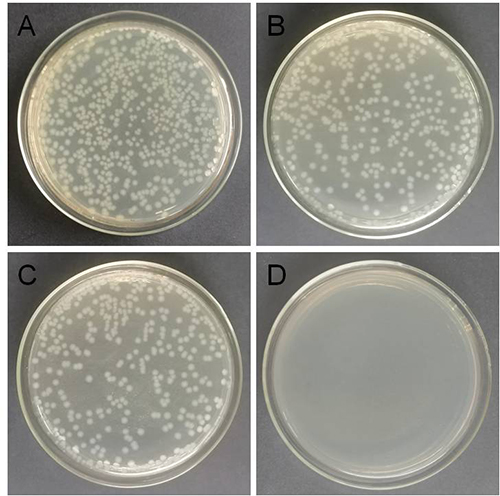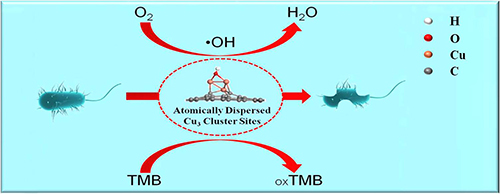Defect-rich Graphene Stabilized Atomically Dispersed Cu3 Clusters with Enhanced Oxidase-Like Activity for Antibacterial Applications
Research Scientist LIU Hongyang and his Ph.D. student MENG Fanchi from Shenyang National Laboratory of Materials Science, cooperated with Prof. MA Ding from Peking University, Prof. XIA Lixin from Liaoning University, Prof. WANG Ning from Hong Kong University of Science and Technology, Research Scientist JIANG Zheng from Shanghai Institute of Applied Physics, Chinese Academy of Science (CAS), Research Scientist WEN Xiaodong from Institute Coal Chemistry, CAS, and their teams, to construct an atomically dispersed and fully exposed Cu3 cluster stabilized on defect-rich nanodiamond-graphene hybrid support (Cu3/ND@G) with unique active adsorption sites, which benefit the adsorption and cleavage of O2, resulting in enhanced oxidase-like and antibacterial activity.
The results was recently published online by Applied Catalysis B: Environmental (DOI:10.1016/j.apcatb.2021.120826).
Modern society witnesses the increasing varieties of bacteria, greatly threatening the health of mankind. Moreover, the extensive use of antibiotics has made some bacteria resistant. Thus, the studying of novel antibacterial materials is in urgent need. Oxidative stress is an effective way to inactivate bacteria. Reactive oxygen species can avidly bind with protein, lipid, polysaccharide, and bacteria membrane, resulting in perforation of bacterial membrane and subsequent cell death.
Nanozyme, a class of nanomaterials with diverse enzyme-like catalytic activity, has attracted great attention. Studies has shown that some nanozymes exhibit oxidase-like or peroxidase-like activities, generating reactive oxygen species with antibacterial effect. However, challenges occur in constructing novel nanozyme with robust enzyme-like catalytic activity.
The discovery of single-atom nanozyme has further attracted great attention. The atomically dispersed metal active sites maximize the utilization of metal atoms, leading to high catalytic activity and metal usage efficiency of the material. Importantly, the coordination structure of isolated metal atoms can be precisely designed and controlled. Thus, the electronic structure and coordination geometry of catalytic active centers can be well depicted, which helps the understanding of the structure-performance correlation of nanozyme. However, single-atom catalysts may encounter low catalytic efficiency and sintering due to the lack of neighboring sites in some reactions. Compared with single atom catalysts, a type of atomically dispersed and fully exposed cluster catalysts was proposed, which can not only provide adjacent metal atoms as catalytic sites but also maintain full atomic utilization efficiency, offering a variety of structural possibilities and catalytic feasibilities for antibacterial applications.
Research Scientist Liu Hongyang and his team have dedicated years into the study of precise design of metal catalyst at atomic scale and its application. Building on previous research, the team reported an atomically dispersed and fully exposed Cu3 cluster stabilized on defect-rich nanodiamond-graphene hybrid support. The aberration-corrected high-angle annular dark-field scanning transmission electron microscopy (AC-HAADF-STEM) images (Fig. 1) shows, Cu3 clusters are anchored on defect-rich nanodiamond-graphene hybrid support. DFT calculation results (as in Fig. 2) reveal that the atomically dispersed Cu3 cluster as active center significantly improves the oxidase-like activity, attributing to the easy dissociation of O2 into reactive oxygen species (?OH). Compared to Cu1/ND@G and Cu-NPs/ND@G, Cu3/ND@G exhibits higher oxidase-like catalytic rate (Kcat=1.474×10-1 s-1). As shown in Fig. 3, Cu3/ND@G demonstrated a great antibacterial rate over 99% in NaAc buffer (ph=4.5). Such a structure of atomically dispersed and full exposed Cu3 cluster presents robust antibacterial activity (as shown in Fig. 4) and shows its potential application in the fields of biomedicine, microbial preservation and etc.
The present work is supported by the National Key R&D Program of China, the National Natural Science Foundation of China, Liaoning Revitalization Talents Program, Shenyang National Laboratory for Materials Science and Shanghai Synchrotron Radiation Facility.

Fig. 1 AC-HAADF-STEM image of Cu-NPs/ND@G at low (A) and high (B) magnifications. AC-HAADF-STEM images of Cu3/ND@G at low (C) and high (D) magnifications.

Fig. 2 The optimized adsorption configurations of various intermediates along the oxidase-like reaction path on Cu3/ND@G and the free-energy diagram for the oxidase-like mechanism on Cu3/ND@G and Cu-NPs/ND@G. The gray, brown, red and white balls represent C, Cu, O, and H atoms, respectively.

Fig. 3 Growth inhibition assay: different materials and bacterial fluid coated on LB agar plate, cultivated with E. coli and treated with: (A) blank, (B) ND@G, (C) Cu-NPs/ND@G and (D) Cu3/ND@G. Incubation condition: 37 °C and 24 h.

Fig. 4 Atomically dispersed and fully exposed Cu3 clusters as active center easily decompose O2 into reactive oxygen species, presenting robust antibacterial activity